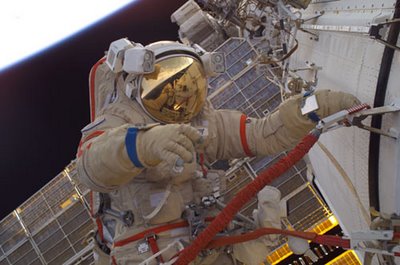In space, no one can hear you pray

[Image: NASA].
Qibla is the direction that a Muslim must face when praying – specifically, toward the Kaaba, in Mecca. In order to align oneself properly with that religious axis mundi, all kinds of complicated mathematical techniques had to be used or developed. From compasses to azimuths – to spherical trigonometry – determining what angle to take in relation to the horizon became as much a mathematical, or geographic, pursuit as it was religious.
So now, as Malaysia prepares to send three Muslim astronauts into space, the question of qibla has once again been revived: in what direction should an astronaut pray in order to face Mecca? As that last link reminds us, these astronauts "will also visit the International Space Station, which circles the earth 16 times in 24 hours, so another thorny question is how to pray five times a day as required by Islam."
I'm imagining a bewildering series of gyroscopes, mirrors, magnets and platforms – called the Prayer Chair – with arms covered in quantum clocks, ticking off "days" where there are none, keeping time in space devoid of terrestrial references. Motors will click and whir, aligning the chair constantly, and whole new branches of robotics – RoboQibla™ – gyroPrayer® – will take off. Science academies throughout the Muslim world will start producing new and strange direction sensors, devices of alignment that'd make John Dee proud and Athanasius Kircher whistle. New space stations designed by architecture students in Dubai will show us the future of intercelestial travel: self-unfolding, solar-powered spaceships, ceaselessly rotating in space – whilst maintaining perfect ship-to-Mecca alignment.
The Jesuits respond with floating cathedrals... flying buttresses in space.
(Original article spotted at Off Center).

Comments are moderated.
If it's not spam, it will appear here shortly!
There's a movie called Pitch Black where a Muslim family are on their way to New Mecca. After they crashland on a planet, they pray by standing in a circle and turning their heads to the sky.
Nice touch, I thought.
Sean out.
Alastair Reynolds also covers similar thought-space in Absolution Gap, from the inside looking out.
Kaaba would be stunning and majesterial launched into orbit around earth, anchored directly above its former terrestrial home. After all, the black corner stone may be meteoric...
As fun as techno-fixes like RoboQibla or the orbital Kaaba are to imagine, Islam already provides examples of creative problem solving similar issues. For example, many people can alter the fasting rituals during Ramadan, depending on their circumstances. People with high nutrition needs such as soldiers, young children, and pregnant women can avoid it entirely, the elderly are encouraged to moderate their intake during the day, and so forth. Or as another example, travellers who can't accurately gauge their geographic relationship to Mecca can pray facing east.
I suspect Muslim astronauts will pray facing a fixed direction (such as the eastern curve of the earth, or toward the center of the earth) at five pre-defined intervals during their wake cycles. Technologically boring but culturally fascinating.
In a moving object, such as an aircraft or a ship(horse or Camel), the Muslim can simply pray in the direction at which the vehicle is headed...
I put these questions to a Muslim cleric and astrometer a number of years back and he said Allah is quite understanding in situations like this. For instance astronauts in Earth orbit (I believe there have been several Muslim astronauts on the shuttle and IIS) can take a best estimate of direction to face. They can also just schedule their prayers on Houston time, thereby ignoring the problem of what to do if you experience a sunrise and sunset every 90 minutes.
Similarly, Muslim scientists at the South Pole don't have to worrry about the fact that they only get one sunrise and sunset each year. They can just set their prayer cycle to GMT, to the time at their home, or any other 24 hour schedule.
Post a Comment